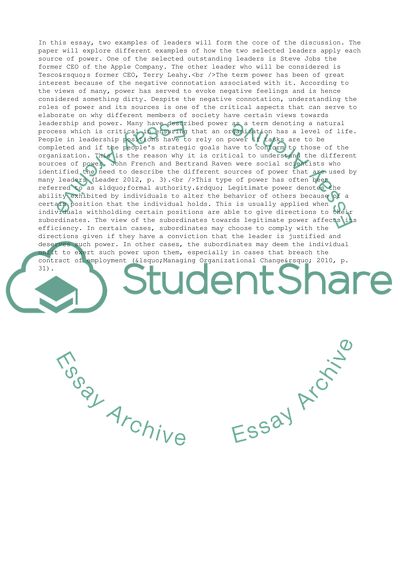Cite this document
(French and Ravens Theory of Sources of Power Essay Example | Topics and Well Written Essays - 1500 words, n.d.)
French and Ravens Theory of Sources of Power Essay Example | Topics and Well Written Essays - 1500 words. https://studentshare.org/management/1829256-describe-french-and-ravens-theory-of-how-leaders-gain-sources-of-powr-in-your-own-words-choose-two-well-known-leadearspolitical-business-historical-and-explain-using-specific-examples-how-they-use-have-used-these-sources-of-power-effectively
French and Ravens Theory of Sources of Power Essay Example | Topics and Well Written Essays - 1500 words. https://studentshare.org/management/1829256-describe-french-and-ravens-theory-of-how-leaders-gain-sources-of-powr-in-your-own-words-choose-two-well-known-leadearspolitical-business-historical-and-explain-using-specific-examples-how-they-use-have-used-these-sources-of-power-effectively
(French and Ravens Theory of Sources of Power Essay Example | Topics and Well Written Essays - 1500 Words)
French and Ravens Theory of Sources of Power Essay Example | Topics and Well Written Essays - 1500 Words. https://studentshare.org/management/1829256-describe-french-and-ravens-theory-of-how-leaders-gain-sources-of-powr-in-your-own-words-choose-two-well-known-leadearspolitical-business-historical-and-explain-using-specific-examples-how-they-use-have-used-these-sources-of-power-effectively.
French and Ravens Theory of Sources of Power Essay Example | Topics and Well Written Essays - 1500 Words. https://studentshare.org/management/1829256-describe-french-and-ravens-theory-of-how-leaders-gain-sources-of-powr-in-your-own-words-choose-two-well-known-leadearspolitical-business-historical-and-explain-using-specific-examples-how-they-use-have-used-these-sources-of-power-effectively.
“French and Ravens Theory of Sources of Power Essay Example | Topics and Well Written Essays - 1500 Words”. https://studentshare.org/management/1829256-describe-french-and-ravens-theory-of-how-leaders-gain-sources-of-powr-in-your-own-words-choose-two-well-known-leadearspolitical-business-historical-and-explain-using-specific-examples-how-they-use-have-used-these-sources-of-power-effectively.


